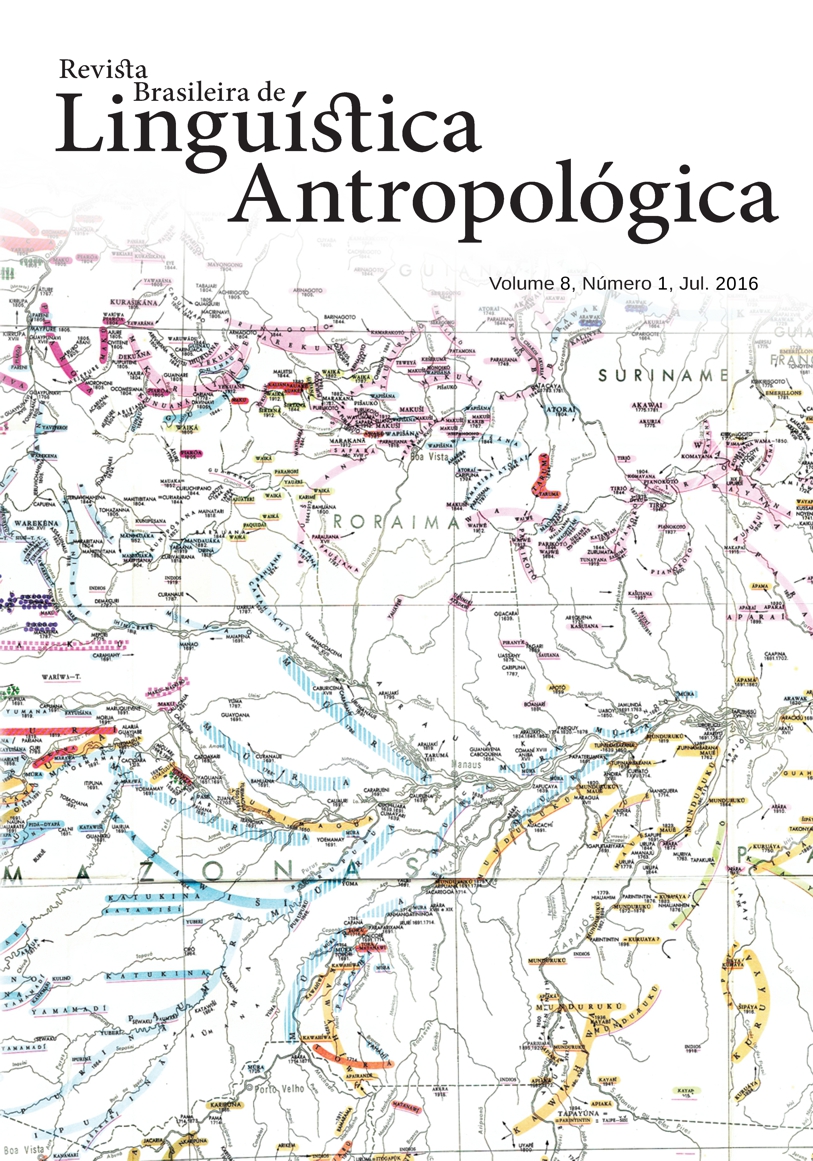A Noção de Tempo: uma construção social e linguística
DOI :
https://doi.org/10.26512/rbla.v8i1.16310Mots-clés :
LinguísticaRésumé
Neste trabalho, contestamos a Hipótese do Mapeamento Universal com base em pesquisa realizada com uma língua Tupi-Kawahib, da Amazônia brasileira: a língua amondawa. Salientamos, entretanto, que não contestamos a hipotética universalidade dos fundamentos cognitivos do mapeamento linguístico espaçotempo.
Téléchargements
Références
Boom, Paul. 1996. Intention, history, and artifact concepts. Cognition 60, 1-29. Clark, Herbert H. 1973. Space, time, semantics and the child. In: Moore, T. E. (Ed.), Cognitive development and the acquisition of language, 27-63. New York: Academic Press.
Dehaene, Stanislas; Izard, Véronique; Spelke, Elizabeth & Pica, Pierre. 2008. Log or linear? Distinct intuitions of the number scale in Western and Amazonian indigene cultures. Science 320, 1217-1220.
Evan, Vyvyan. 2004. The structure of time: Language, meaning and temporal cognition. Amsterdam: John Benjamins.
Evans-Pritchard, Edward E. 1939. Nuer time-reckoning. Africa: Journal of the International African Institute 12 (2),189-216.
Evans-Pritchard, Edward E. 1940. Nuer. Oxford: Oxford University Press.
Fauconnier, Gilles and Turner, Mark. 2008. Rethinking metaphor. In. Ray Gibbs (ed.) The Cambridge handbook of metaphor and thought, 53-66. Cambridge: Cambridge University Press.
González, Hebe Alicia. 2005. A Grammar of Tapiete (Tupi-Guarani). Pittsburgh, PA: University of Pittsburgh PhD thesis.
Grady, Joseph. 1999. A typology of motivation for conceptual metaphor: Correlation vs. resemblance. In: Ray Gibbs & Gerard Steen (eds.), Metaphor in cognitive linguistics, 175-204. Amsterdam: John Benjamins.
Haspelmath, Martin. 1997. From Space to time: Temporal adverbials in the world’s languages (Lincom Studies in Theoretical Linguistics 3). Munich: Lincom Europa.
Hutchins, Edwin. 2005. Material anchors for conceptual blends. Journal of Pragmatics 37, 1555-1577.
Keyes, Charles F. 1975. Buddhist pilgrimage centers and the twelve-year cycle: Northern Thai moral orders in space and time. History of Religions, 15 (1), 71-89.
Lakoff, George, and Johnson, Mark. 1980. Metaphors we live by. Chicago: University of Chicago Press.
Lakoff, George, and Johnson, Mark. 1999. Philosophy in the flesh: The embodied mind and its challenge to Western thought. New York: Basic Books.
Langacker, Ronald W. 1987. Foundations of cognitive grammar. Vol. 1. Theoretical prerequisites. Stanford, CA: Stanford University Press.
Leite, Yonne de Freitas. 2000. A Gramática de Anchieta. Ciência Hoje, 28 (163), 43-47.
Moore, Kevin. 2006. Space-to-time mappings and temporal concepts. Cognitive Linguistics 17,199-244.
Muysken, Pieter. 2008. Nominal tense. Time for further Whorfian adventures? Commentary on Casasanto. Language Learning 58: Suppl. 1, 81-88.
Núñez, Rafael and Sweetser, Eve. 2006. With the future behind them: convergent evidence from Aymara language and gesture in the crosslinguistic comparison of spatial construals of time. Cognitive Science 30, 1-49.
Pérez, Aveline. 1990. Time in motion: Grammaticalization of the be going to construction in English. La Trobe University Working Papers in Linguistics 3, 49”“ 64.
Pica, Pierre; Lemer, Cathy; Izard, Véronique, and Dehaene, Stanislas. 2004. Exact and approximate arithmetic in an Amazonian indigene group. Science 306, 499-503.
Sinha, Chris. 1988. Language and representation: A socio-naturalistic approach to human development. Hemel Hempstead: Harvester-Wheatsheaf.
Sinha, Chris and Jensen de López, Kristine. 2000. Language, culture and the embodiment of spatial cognition. Cognitive Linguistics 11, 17-41.
Talmy, Leonard. 1983. How language structures space. In: Herbert L. Pick, Jr. and Linda P. Acredolo (Eds.). Spatial orientation: Theory, research and application, 225- 282. New York: Plenum Press.
Talmy, Leonard. 1985. Lexicalization patterns: semantic structure in lexical forms. In: T. Shopen (ed.), Language typology and syntactic description. Vol. 3, Grammatical categories and the lexicon, 36-149. Cambridge: Cambridge University Press.
Talmy, Leonard. 1991. Path to realization: a typology of event conflation. Proceedings of the 17th Annual Meeting of the Berkeley Linguistics Society, 480-520. Berkeley, UC Berkeley.
Talmy, Leonard. 1999. Fictive motion in language and “ception”. In. P. Bloom, M. Peterson, L. Nadel & M. Garrett (eds.), Language and Space, 211-276. Cambridge, MA: MIT Press.
Tomasello, Michael. 1999. The cultural origins of human cognition. Cambridge, MA: Harvard University Press.
Yu, Ning. 1998. The contemporary theory of metaphor: A perspective from Chinese. Amsterdam: John Benjamins.
Zinken, Jörg; Sampaio, Wany; da Silva Sinha, Vera & Sinha, Chris. 2005. Space, motion and time in Amondawa: Field manual 2005-6. Portsmouth: University of Portsmouth.
Téléchargements
Publié-e
Comment citer
Numéro
Rubrique
Licence
(c) Tous droits réservés Revista Brasileira de Linguística Antropológica 2017

Cette œuvre est sous licence Creative Commons Attribution 4.0 International.
Les auteurs qui publient dans RBLA acceptent les conditions suivantes :
a) Les auteurs conservent le droit d'auteur et accordent à la revue le droit de première publication, et l'œuvre est simultanément sous licence Creative Commons Attribution License, qui permet le partage de l'œuvre avec la reconnaissance de la paternité de l'œuvre et la publication initiale dans cette revue .
b) Les auteurs sont autorisés à conclure des contrats supplémentaires séparément, pour la distribution non exclusive de la version de l'œuvre publiée dans cette revue (par exemple, publier dans un référentiel institutionnel ou sous forme de chapitre de livre), avec reconnaissance de la paternité et de la publication initiale dans ce journal.
c) Les auteurs sont autorisés et encouragés à publier leur travail en ligne (par exemple, dans des référentiels institutionnels ou sur leur page personnelle) à tout moment avant ou pendant le processus éditorial, car cela peut générer des changements productifs, ainsi qu'augmenter l'impact et la citation de l'ouvrage publié.







